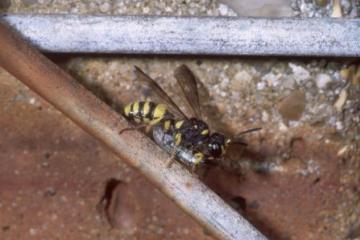Species Account for Cerceris quadricincta
Cerceris quadricincta (Panzer, 1799)
Four-banded Weevil-wasp
Aculeata: Crabronidae

Reproduction for study and non-profit use permitted, all other rights reserved.
Taxonomic group: bees and wasps (Aculeata) - County data
View time series maps for Cerceris quadricincta
member log-on for taxon report
Status: RDB 1;Section 41 Priority Species
Essex RDB: Listed
Threat: Essex Endangered
Images
upload a new image
Essex Red Data List comment
preys on weevils
Species text
The RDB1 Cerceris quadricincta (4-banded Tailed Digger Wasp) is a medium-sized yellow and black wasp which nests gregariously in areas of bare sand or sand-clay substrates in places exposed to the sun. It provisions its nest with adult weevils. This wasp has historically been recorded from the Colchester area in Essex and several locations in Kent. Liverpool Museum have supplied data from the Dicker collection which includes records of the wasp in Kent at Ramsgate in 1979, Grain in 1979, Swanscombe between 1977 and 1983 and Upnor between 1979 and 1984. Specimens from Upnor and Ramsgate have been examined and confirmed. The continuing occurrence of the wasp at the two sites at Upnor and Ramsgate has been established (Harvey, 2002a; Edwards, 2004), but the Swanscombe and Grain sites have probably been lost to development. Jerry Bowdrey identified a possible nesting aggregation on the side of the footpath on the northern side of the Cowdrey Centre Ozalid site in Colchester at the beginning of July 2001 and this was confirmed by a further visit by both Peter Harvey and Jerry Bowdrey and on subsequent occasions. It has since been recorded from a number of sites in the Colchester area and a single male was collected in South Essex from the ashfields at Tilbury by Peter Harvey in 2007.
Autecological work has shown that prey weevils consist of widespread and common species, but the wasp may be associated with habitats where these occur in abundance, such as sporadically disturbed land waste ground and flower-rich edge areas of heath and acid grassland. Nesting seems to require hot south-facing conditions, and it is likely that climatic factors and local aspect are important. However the extreme rarity of the wasp is not properly understood. The wasp is host to the Red Data Book cleptoparasitic ruby tailed wasp Hedychrum niemelai. The UK Biodiversity Action Plan for the 4-banded Tailed Digger Wasp states 'Maintain populations at all known sites', 'Enhance the population size at all known sites by 2010', 'Restore populations to suitable sites to maintain 10 viable populations within the historic range by 2010'. The plan also states 'Consider notifying sites supporting viable populations of Cerceris quadricincta as SSSIs, where this is necessary to secure their long-term protection and appropriate management' and 'Where possible, ensure that all occupied and nearby potential habitat is appropriately managed by 2008, for example through SSSI or agri-environment scheme management agreements'; 'Ensure that habitat requirements of Cerceris quadricincta are taken into account in relevant development policies, plans and proposals'. References
Habitats
Recorded management for locations with Cerceris quadricincta
Recorded substrate and hydrology for locations with Cerceris quadricincta
Why not join the Club, register and add a new species page
Interpretation of distribution maps





















